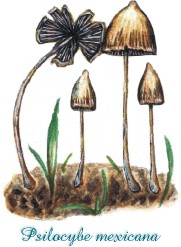Psilocybe mexicana
Psilocybe mexicana is a species of psychedelic mushroom that contains the psychoactive compounds psilocybin and psilocin. It is most commonly found in Mexico, Central America, and the southern parts of the United States. Psilocybe mexicana has been known to indigenous peoples of the Americas for thousands of years and has been used in traditional spiritual and religious ceremonies, particularly by the Aztec civilization, where it was known as teonanácatl, meaning "divine mushroom". The mushroom grows in meadows and wooded areas, particularly in limestone-rich soils. It is characterized by its small size, conical to bell-shaped cap, and the presence of a ring around its stem. The cap color can vary from light brown to yellowish-brown, and it becomes bluish when bruised due to the oxidation of psilocin. The discovery of Psilocybe mexicana in the Western world is attributed to Robert Gordon Wasson, an amateur mycologist and vice president of J.P. Morgan & Co., who, along with his wife Valentina Pavlovna Wasson, participated in a traditional Mazatec mushroom ceremony in Mexico in 1955. Their experiences were published in Life magazine in 1957, sparking widespread interest in psychedelic mushrooms. The active compounds in Psilocybe mexicana, psilocybin and psilocin, were isolated and synthesized by Swiss chemist Albert Hofmann in 1958, who also discovered LSD. Hofmann extracted the compounds from the Psilocybe mexicana species, among others, and his work laid the foundation for the study of psychedelics in psychology and psychiatry. In modern times, Psilocybe mexicana, along with other psychedelic mushrooms, has been the subject of scientific research for its potential therapeutic benefits. Studies have explored its use in treating conditions such as depression, anxiety, and post-traumatic stress disorder (PTSD), with promising results. However, the legal status of Psilocybe mexicana varies by country, with its possession, sale, and use being illegal in many parts of the world. Despite legal restrictions, Psilocybe mexicana continues to be used in traditional ceremonies by indigenous groups, as well as recreationally and spiritually by people seeking to explore the depths of their consciousness.
Search WikiMD
Ad.Tired of being Overweight? Try W8MD's physician weight loss program.
Semaglutide (Ozempic / Wegovy and Tirzepatide (Mounjaro / Zepbound) available.
Advertise on WikiMD
|
WikiMD's Wellness Encyclopedia |
| Let Food Be Thy Medicine Medicine Thy Food - Hippocrates |
Translate this page: - East Asian
中文,
日本,
한국어,
South Asian
हिन्दी,
தமிழ்,
తెలుగు,
Urdu,
ಕನ್ನಡ,
Southeast Asian
Indonesian,
Vietnamese,
Thai,
မြန်မာဘာသာ,
বাংলা
European
español,
Deutsch,
français,
Greek,
português do Brasil,
polski,
română,
русский,
Nederlands,
norsk,
svenska,
suomi,
Italian
Middle Eastern & African
عربى,
Turkish,
Persian,
Hebrew,
Afrikaans,
isiZulu,
Kiswahili,
Other
Bulgarian,
Hungarian,
Czech,
Swedish,
മലയാളം,
मराठी,
ਪੰਜਾਬੀ,
ગુજરાતી,
Portuguese,
Ukrainian
Medical Disclaimer: WikiMD is not a substitute for professional medical advice. The information on WikiMD is provided as an information resource only, may be incorrect, outdated or misleading, and is not to be used or relied on for any diagnostic or treatment purposes. Please consult your health care provider before making any healthcare decisions or for guidance about a specific medical condition. WikiMD expressly disclaims responsibility, and shall have no liability, for any damages, loss, injury, or liability whatsoever suffered as a result of your reliance on the information contained in this site. By visiting this site you agree to the foregoing terms and conditions, which may from time to time be changed or supplemented by WikiMD. If you do not agree to the foregoing terms and conditions, you should not enter or use this site. See full disclaimer.
Credits:Most images are courtesy of Wikimedia commons, and templates Wikipedia, licensed under CC BY SA or similar.
Contributors: Prab R. Tumpati, MD

